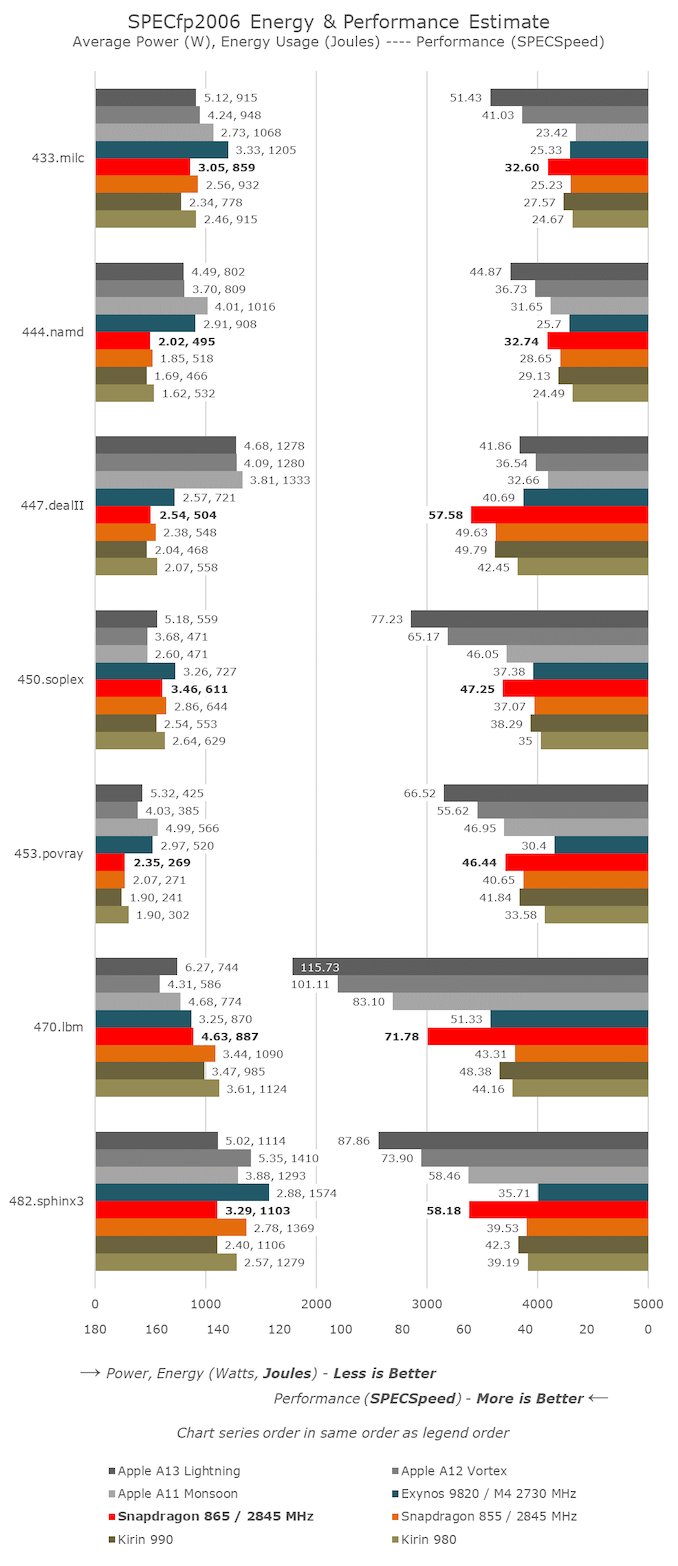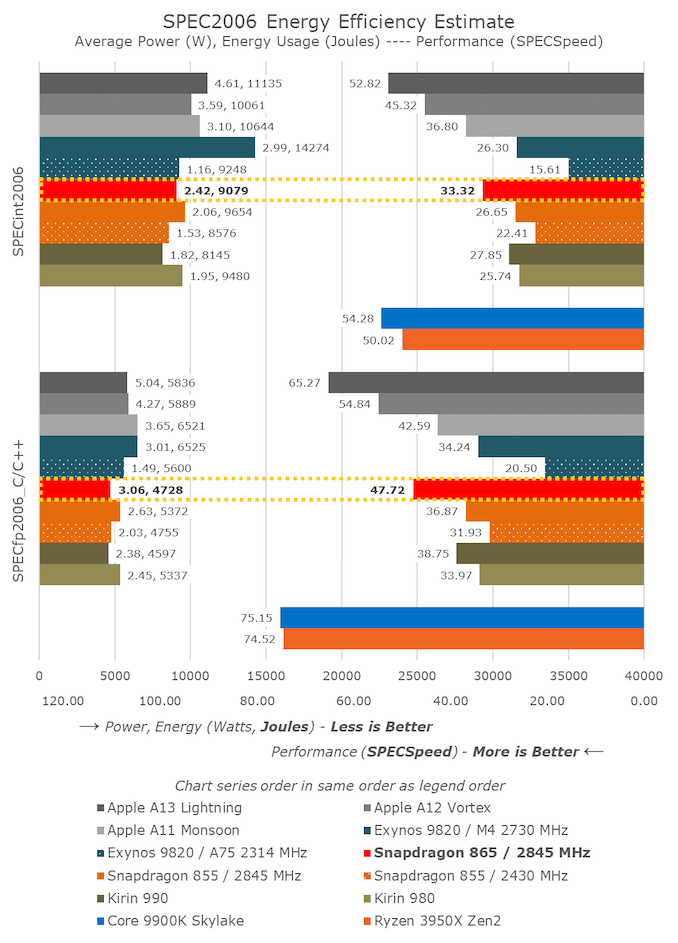The Snapdragon 865 Performance Preview: Setting the Stage for Flagship Android 2020
by Andrei Frumusanu on December 16, 2019 7:30 AM EST- Posted in
- Mobile
- Qualcomm
- Smartphones
- 5G
- Cortex A77
- Snapdragon 865
CPU Performance & Efficiency: SPEC2006
We’re moving on to SPEC2006, analysing the new single-threaded performance of the new Cortex-A77 cores. As the new CPU is running at the same clock as the A76-derived design of the Snapdragon 855, any improvements we’ll be seeing today are likely due to the IPC improvements of the core, the doubled L3 cache, as well as the enhancements to the memory controllers and memory subsystem of the chip.
Disclaimer About Power Figures Today:
The power figures presented today were captured using the same methodology we generally use on commercial devices, however this year we’ve noted a large discrepancy between figures reported by the QRD865’s fuel-gauge and the actual power consumption of the device. Generally, we’ve noted that there’s a discrepancy factor of roughly 3x. We’ve reached out to Qualcomm and they confirmed in a very quick testing that there’s a discrepancy of >2.5x. Furthermore, the QRD865 phones this year again suffered from excessive idle power figures of >1.3W.
I’ve attempted to compensate the data as best I could, however the figures published today are merely preliminary and of lower confidence than usual. For what it’s worth, last year, the QRD855 data was within 5% of the commercial phones’ measurements. We’ll be naturally re-testing everything once we get our hands on final commercial devices.
In the SPECint2006 suite, we’re seeing some noticeable performance improvements across the board, with some benchmarks posting some larger than expected increases. The biggest improvements are seen in the memory intensive workloads. 429.mcf is DRAM latency bound and sees a massive improvement of up to 46% compared to the Snapdragon 855.
What’s interesting to see is that some execution bound benchmarks such as 456.hmmer seeing a 28% upgrade. The A77 has an added 4th ALU which represents a 33% throughput increase in simple integer operations, which I don’t doubt is a major reason for the improvements seen here.
The improvements aren’t across the board, with 400.perlbench in particular seeing even a slight degradation for some reason. 403.gcc also saw a smaller 12% increase – it’s likely these benchmarks are bound by other aspects of the microarchitecture.
The power consumption and energy efficiency, if the numbers are correct, roughly match our expectations of the microarchitecture. Power has gone up with performance, but because of the higher performance and smaller runtime of the workloads, energy usage has remained roughly flat. Actually in several tests it’s actually improved in terms of efficiency when compared to the Snapdragon 855, but we’ll have to wait on commercial devices in order to make some definitive conclusions here.
In the SPECfp2006 suite, we’re seeing also seeing some very varied improvements. The biggest change happened to 470.lbm which has a very big hot loop and is memory bandwidth hungry. I think the A77’s new MOP-cache here would help a lot in regards to the instruction throughput, and the improved memory subsystem makes the massive 65% performance jump possible.
Arm actually had advertised IPC improvements of ~25% and ~35% for the int and FP suite of SPEC2006. On the int side, we’re indeed hitting 25% on the Snapdragon 865, compared to the S855, however on the FP side we’re a bit short as the increase falls in at around 29%. The performance increases here strongly depend on the SoC and particular on the memory subsystem, compared to the Kirin 990’s A76 implementation the increases here are only 20% and 24%, but HiSilicon’s chip also has a stronger memory subsystem which allows it to gain quite more performance over the A76’s in the S855.
The overall results for SPEC2006 are very good for the Snapdragon 865. Performance is exactly where Qualcomm advertised it would land at, and we’re seeing a 25% increase in SPECint2006 and a 29% in SPECfp2006. On the integer side, the A77 still trails Apple’s Monsoon cores in the A11, but the new Arm design now has been able to trounce it in the FP suite. We’re still a bit far away from the microarchitectures catching up to Apple’s latest designs, but if Arm keeps up this 25-30% yearly improvement rate, we should be getting there in a few more iterations.
The power and energy efficiency figures, again, taken with a grain of salt, are also very much in line with expectations. Power has slightly increased with performance this generation, however due to the performance increase, energy efficiency has remained relatively flat, or has even seen a slight improvement.














178 Comments
View All Comments
iphonebestgamephone - Tuesday, December 31, 2019 - link
"I am into android from the start + symbian before than and also senior member with dev/helping known devs with project @ xda. So thank you, I know enough about android." Haha... I should have known you would come up with something like that."Btw, used android for 10 years (only high end phones) till I switched to the pro max + I have highly technical background as education, hobby and work - especially in the field of electronics and computers" this one too lol.
And then you somehow decide civ6 and deadcells dont run cus android too weak. No. Its just the devs dont bother with it. They could have restricted it to atleast sd820 devices like what grid autosport devs are doing.
"Emulation is cool, did a lot on android with it. Including fun stuff like running diablo 2 LOD latest patch on my note 9, believe me - it's playable with the spen when on the go, in home one mouse and the TV = you are good to go. Still, ported or developed games for mobile just works better and you have such a vast library nowdays with high quality games that you really don't need to revisit old classics on your phone. Actually on ios the situation is a lot better, you got a lot more paid apps there vs android." Im yet to find some good stuff like god of war, nfs, burnout, wipeout, xenoblade, pokemon, zelda or mario, on android, or any other thousands of games. You could say you can stream them, but same goes for pc games too. Emulators and a switch style gamepad is great on the go. I see apple has done a great job with metal, vulkan is worse than opengl on android 10 sd855. Looking forward to the updatable drivers on the 865.
"I can play fortnite maxed at 60fps and no fps drops or whatever even after 2 hours of play without major heating and you are talking about PUBG maxed. :)"
Thats awesome, sd855 heats up a lot on pubg maxed. I guess there is no pubg gfxtool for ios.
cha0z_ - Thursday, January 2, 2020 - link
There are emulators for ios and you don't need jailbreak to install/play games. They are not on the app store tho, they are on custom stores - still, it's not any different than installing APK from outside playstore. The emulators library is quite big, including ppsspp. As I said tho - android is better for emulators imho + I didn't say android is weak as OS. Weak are the SOCs on android phones compared to the A series of apple. I would totally love to see android phone with apple SOC/similar performance to it and longer full support than two years.As for the gfxtool, I hope you understand that when you have literally just a few phones to optimise for - you really do a great job with it, or with other words - the ios pubg variant is greatly optimised for every iphone that supports it to extract the best experience with the best possible gfx for the hardware. Ofc you can argue than personal preferences can apply and tweaking can be done, but it's not that necessary.
I respect your opinion and share few viewpoints, just from personal experience - gaming on ios is generally better. Hard to explain, games run smoother and better. If you love emulators tho - android is obviously a better choice + snapdragon SOC.
iphonebestgamephone - Tuesday, January 7, 2020 - link
"Weak are the SOCs on android phones compared to the A series of apple." Yeah everyone knows. They still are strong enough for the games you mentioned though, atleast the last 2 years of flagships. And last years 730/730g are also good enough. I guess the devs want even those with 100$ phones play their games. I doubt those people would even bother buying the game once it hits the store.Gamebench did a test and the huawei mate 30 pro actually performed better than the iphone 11 pro amd note 10 in games. https://blog.gamebench.net/huawei-mate-30-pro-ipho...
The iphone probably had better visual settings/higher resolution as default probably.
Ahmedrr1 - Sunday, December 22, 2019 - link
Nicehttps://www.technewsahmed.com/2019/12/huaweis-p30-...
AceMcLoud - Sunday, December 22, 2019 - link
Ouch, that doesn't look very promising.ballsystemlord - Friday, February 7, 2020 - link
Spelling error:"The test here is mostly sensible to the performance scaling of the A55 cores. The QRD865 in the default more is more conservative than some existing S855 devices,"
"mode" not "more":
"The test here is mostly sensible to the performance scaling of the A55 cores. The QRD865 in the default mode is more conservative than some existing S855 devices,"
Hrel - Tuesday, April 28, 2020 - link
Man these Watt listings make no sense at all.5.12 Watts is shows as lower than 4.24 Watts then 2.73W is somehow HIGHER than that?! WTF is going on?
Then 3.33W is higher than 2.73, which makes sense, but then 3.05W is lower than 2.56W?! What are these charts?
Hrel - Tuesday, April 28, 2020 - link
Oh, the bar is for the Joules, the Watts aren't visually represented. Runtime being a critical variable, I gotcha now. Lol, I was so confused :)